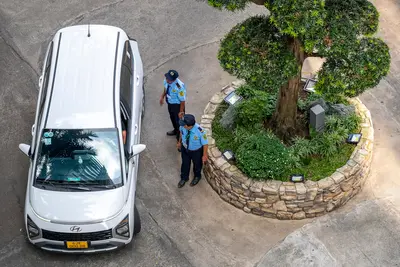🔐 Configuring System Access Controls: Simple Guide
Let’s configure system access controls on your Alpine Linux system! 🛡️ This guide uses easy steps and simple words. We’ll secure your system like a digital fortress! 😊
🤔 What are System Access Controls?
System access controls are like having security guards and keycards that decide who can enter which rooms in a building!
Think of access controls like:
- 📝 A VIP list at an exclusive event that checks who gets in
- 🔧 A keycard system that unlocks specific doors for authorized people
- 💡 A security checkpoint that verifies identity and permissions
🎯 What You Need
Before we start, you need:
- ✅ Alpine Linux system running
- ✅ Root access or sudo permissions
- ✅ Basic understanding of users and groups
- ✅ Knowledge of file permissions concepts
📋 Step 1: Understand Access Control Basics
Learn About Permission Systems
First, let’s understand the different types of access controls! 😊
What we’re doing: Exploring the various access control mechanisms available in Alpine Linux to understand what we’re configuring.
# Check current user and groups
whoami
id
groups
# View file permissions
ls -la /etc/passwd
ls -la /home/
ls -la /var/log/
# Check access control lists (if available)
getfacl /etc/passwd 2>/dev/null || echo "ACLs not available"
# View current sudo configuration
cat /etc/sudoers
# Check system users and groups
cat /etc/passwd | head -10
cat /etc/group | head -10
# View login restrictions
cat /etc/security/limits.conf 2>/dev/null || echo "limits.conf not found"
# Check for PAM modules
ls /lib/security/ 2>/dev/null || ls /usr/lib/security/ 2>/dev/null || echo "PAM modules directory not found"What this does: 📖 Shows you the current security landscape and what access controls are already in place.
Example output:
uid=1000(alice) gid=1000(alice) groups=1000(alice),100(users),27(sudo)
-rw-r--r-- 1 root root 1234 Jun 3 14:30 /etc/passwd
drwxr-xr-x 3 root root 4096 Jun 3 13:15 /home/
root:x:0:0:root:/root:/bin/ash
daemon:x:1:1:daemon:/usr/sbin:/bin/false
bin:x:2:2:bin:/bin:/bin/falseWhat this means: You can see current permissions and user structure! ✅
💡 Important Tips
Tip: Always test access controls in a safe environment first! 💡
Warning: Incorrect access controls can lock you out of your system! ⚠️
🛠️ Step 2: Configure User-Based Access Controls
Set Up Proper User Management
Now let’s configure detailed user access controls! 😊
What we’re doing: Creating a comprehensive user management system with proper access controls and security policies.
# Install additional security tools
apk add sudo shadow acl attr
# Create user groups for different access levels
groupadd administrators
groupadd developers
groupadd operators
groupadd auditors
groupadd guests
# Create test users with different access levels
useradd -m -s /bin/ash -G administrators admin_user
useradd -m -s /bin/ash -G developers dev_user
useradd -m -s /bin/ash -G operators ops_user
useradd -m -s /bin/ash -G auditors audit_user
useradd -m -s /bin/ash -G guests guest_user
# Set strong password policies
cat > /etc/login.defs << 'EOF'
# Password aging controls
PASS_MAX_DAYS 90
PASS_MIN_DAYS 1
PASS_MIN_LEN 8
PASS_WARN_AGE 7
# User/group ID ranges
UID_MIN 1000
UID_MAX 60000
GID_MIN 1000
GID_MAX 60000
# Home directory creation
CREATE_HOME yes
UMASK 077
# Login settings
LOGIN_RETRIES 3
LOGIN_TIMEOUT 60
EOF
# Configure sudo access with granular permissions
cat > /etc/sudoers.d/access-controls << 'EOF'
# Group-based sudo access
%administrators ALL=(ALL:ALL) ALL
%developers ALL=(ALL) /usr/bin/systemctl, /usr/bin/tail, /usr/bin/less, /bin/ls
%operators ALL=(ALL) /usr/bin/systemctl restart *, /usr/bin/systemctl status *, /usr/bin/tail /var/log/*
%auditors ALL=(ALL) /usr/bin/tail /var/log/*, /usr/bin/less /var/log/*, /bin/ls /var/log/*, NOPASSWD: /usr/bin/find /var/log/
# Disable root password login
Defaults requiretty
Defaults env_reset
Defaults secure_path="/usr/local/sbin:/usr/local/bin:/usr/sbin:/usr/bin:/sbin:/bin"
# Command aliases for easier management
Cmnd_Alias LOG_COMMANDS = /usr/bin/tail, /usr/bin/less, /usr/bin/grep, /usr/bin/awk
Cmnd_Alias SERVICE_COMMANDS = /usr/bin/systemctl start, /usr/bin/systemctl stop, /usr/bin/systemctl restart
Cmnd_Alias MONITORING_COMMANDS = /usr/bin/top, /usr/bin/htop, /usr/bin/ps, /usr/bin/netstat
# User-specific permissions
dev_user ALL=(www-data) /usr/bin/systemctl restart nginx
ops_user ALL=(ALL) SERVICE_COMMANDS, MONITORING_COMMANDS
audit_user ALL=(ALL) NOPASSWD: LOG_COMMANDS
EOF
# Set proper file permissions
chmod 440 /etc/sudoers.d/access-controls
# Test sudo configuration
visudo -c
# Create directory structure with proper permissions
mkdir -p /opt/shared/{public,restricted,confidential}
mkdir -p /var/log/app/{public,restricted,confidential}
# Set directory permissions
chmod 755 /opt/shared/public
chmod 750 /opt/shared/restricted
chmod 700 /opt/shared/confidential
# Set group ownership
chgrp guests /opt/shared/public
chgrp operators /opt/shared/restricted
chgrp administrators /opt/shared/confidential
# Set sticky bit for shared directories
chmod +t /opt/shared/publicAccess control structure created:
administrators: Full system access
developers: Limited system commands + development tools
operators: Service management + monitoring
auditors: Read-only access to logs and system info
guests: Basic file access onlyWhat this means: You have layered access controls based on user roles! 🎉
🎮 Step 3: Implement File Access Controls
Configure Advanced File Permissions
Let’s set up detailed file-level access controls! 🎯
What we’re doing: Implementing Access Control Lists (ACLs) and extended file attributes for fine-grained file access management.
# Enable ACL support on filesystem (if not already enabled)
mount -o remount,acl /
# Check if ACLs are supported
tune2fs -l /dev/$(df / | tail -1 | awk '{print $1}' | sed 's|/dev/||') | grep "Default mount options"
# Create test files for access control demonstration
touch /opt/shared/public/public_file.txt
touch /opt/shared/restricted/restricted_file.txt
touch /opt/shared/confidential/confidential_file.txt
# Set basic permissions
chmod 644 /opt/shared/public/public_file.txt
chmod 640 /opt/shared/restricted/restricted_file.txt
chmod 600 /opt/shared/confidential/confidential_file.txt
# Apply Access Control Lists (ACLs)
# Give developers read access to restricted files
setfacl -m g:developers:r /opt/shared/restricted/restricted_file.txt
# Give auditors read access to all files
setfacl -m g:auditors:r /opt/shared/restricted/restricted_file.txt
setfacl -m g:auditors:r /opt/shared/confidential/confidential_file.txt
# Give specific user write access
setfacl -m u:ops_user:rw /opt/shared/restricted/restricted_file.txt
# Set default ACLs for directories (inherited by new files)
setfacl -d -m g:developers:r /opt/shared/restricted/
setfacl -d -m g:auditors:r /opt/shared/restricted/
setfacl -d -m g:auditors:r /opt/shared/confidential/
# View ACL settings
getfacl /opt/shared/restricted/restricted_file.txt
getfacl /opt/shared/confidential/confidential_file.txt
# Create immutable files (can't be modified or deleted)
chattr +i /opt/shared/public/important_config.txt 2>/dev/null || echo "chattr not available"
# Create append-only files (can only be appended to)
touch /var/log/audit.log
chattr +a /var/log/audit.log 2>/dev/null || echo "chattr not available"
# Set extended attributes for file classification
setfattr -n user.security_level -v "restricted" /opt/shared/restricted/restricted_file.txt 2>/dev/null || echo "Extended attributes not available"
setfattr -n user.department -v "IT" /opt/shared/restricted/restricted_file.txt 2>/dev/null || echo "Extended attributes not available"
# View extended attributes
getfattr -d /opt/shared/restricted/restricted_file.txt 2>/dev/null || echo "Extended attributes not available"File access levels created:
Public files: Everyone can read
Restricted files: Group members + specific ACLs
Confidential files: Owner + administrators only
Immutable files: Cannot be changed
Append-only files: Can only grow (perfect for logs)Great job! Advanced file access controls are configured! 🌟
📊 Step 4: Network Access Controls
Secure Network-Based Access
Now let’s configure network-level access controls! 😊
What we’re doing: Setting up firewall rules and network access policies to control who can access system services from the network.
# Install and configure iptables
apk add iptables iptables-openrc
# Create baseline firewall rules
cat > /etc/iptables/rules-save << 'EOF'
*filter
:INPUT DROP [0:0]
:FORWARD DROP [0:0]
:OUTPUT ACCEPT [0:0]
# Allow loopback traffic
-A INPUT -i lo -j ACCEPT
-A OUTPUT -o lo -j ACCEPT
# Allow established and related connections
-A INPUT -m conntrack --ctstate ESTABLISHED,RELATED -j ACCEPT
# Allow SSH from specific networks only
-A INPUT -p tcp --dport 22 -s 192.168.1.0/24 -j ACCEPT
-A INPUT -p tcp --dport 22 -s 10.0.0.0/8 -j ACCEPT
# Allow HTTP/HTTPS from anywhere (if web server)
-A INPUT -p tcp --dport 80 -j ACCEPT
-A INPUT -p tcp --dport 443 -j ACCEPT
# Allow ping with rate limiting
-A INPUT -p icmp --icmp-type echo-request -m limit --limit 5/sec -j ACCEPT
# Log dropped packets
-A INPUT -j LOG --log-prefix "DROPPED: " --log-level 4
-A INPUT -j DROP
COMMIT
EOF
# Load firewall rules
iptables-restore < /etc/iptables/rules-save
# Start and enable firewall
rc-service iptables start
rc-update add iptables default
# Configure TCP Wrappers for service-level access control
cat > /etc/hosts.allow << 'EOF'
# Allow SSH from local networks
sshd: 192.168.1.0/255.255.255.0
sshd: 10.0.0.0/255.0.0.0
sshd: LOCAL
# Allow rsyslog from specific hosts
rsyslogd: 192.168.1.10
rsyslogd: 192.168.1.11
# Allow all local connections
ALL: LOCAL
# Allow administrators from specific IPs
ALL: 192.168.1.100
EOF
cat > /etc/hosts.deny << 'EOF'
# Deny all other connections
ALL: ALL
EOF
# Configure SSH access controls
cat >> /etc/ssh/sshd_config << 'EOF'
# User and group restrictions
AllowUsers admin_user dev_user ops_user
AllowGroups administrators developers operators
# Disable root login
PermitRootLogin no
# Disable password authentication for specific users
Match User guest_user
PasswordAuthentication no
PubkeyAuthentication yes
# Time-based access restrictions
Match Group developers
ForceCommand /usr/local/bin/time-restricted-shell
# IP-based restrictions
Match Address 192.168.1.0/24
PasswordAuthentication yes
Match Address !192.168.1.0/24
PasswordAuthentication no
PubkeyAuthentication yes
EOF
# Create time-restricted shell script
cat > /usr/local/bin/time-restricted-shell << 'EOF'
#!/bin/bash
# Time-restricted shell for developers (9 AM to 6 PM)
current_hour=$(date +%H)
current_day=$(date +%u) # 1-7, Monday-Sunday
# Check if it's business hours (9 AM to 6 PM, Monday-Friday)
if [ $current_day -le 5 ] && [ $current_hour -ge 9 ] && [ $current_hour -lt 18 ]; then
# Business hours - allow normal shell
exec /bin/ash "$@"
else
echo "Access denied: Outside business hours (9 AM - 6 PM, Monday-Friday)"
echo "Emergency access: Contact system administrator"
exit 1
fi
EOF
chmod +x /usr/local/bin/time-restricted-shell
# Restart SSH service
rc-service sshd restartNetwork access controls implemented:
- Firewall rules blocking unauthorized access
- TCP Wrappers for service-level control
- SSH restrictions by user, group, time, and IP
- Rate limiting for network services
What this creates:
SSH access: Limited to specific networks and users
Service access: Controlled by TCP Wrappers
Time limits: Business hours access for developers
IP restrictions: Different rules for different networksAwesome work! Network access controls are secured! 🌟
📊 Quick Summary Table
| What to Do | Command | Result |
|---|---|---|
| 🔧 Create user groups | groupadd administrators | ✅ Role-based access |
| 🛠️ Configure sudo | /etc/sudoers.d/access-controls | ✅ Command permissions |
| 🎯 Set up ACLs | setfacl -m g:group:r file | ✅ Fine-grained file access |
| 🚀 Configure firewall | iptables rules | ✅ Network access control |
🌐 Step 5: Monitoring and Auditing Access
Track and Monitor Access Controls
Let’s set up comprehensive access monitoring! 🌐
What we’re doing: Implementing logging and monitoring systems to track access control usage and detect security violations.
# Install audit daemon
apk add audit
# Configure audit rules
cat > /etc/audit/audit.rules << 'EOF'
# Delete all existing rules
-D
# Buffer size
-b 8192
# Failure mode (0=silent, 1=printk, 2=panic)
-f 1
# Audit system calls for file access
-a always,exit -F arch=b64 -S openat -F success=0 -k file_access_failures
-a always,exit -F arch=b64 -S openat -F success=1 -F path=/opt/shared/confidential -k confidential_access
# Audit sudo usage
-a always,exit -F arch=b64 -S execve -F path=/usr/bin/sudo -k sudo_usage
# Audit user login/logout
-w /var/log/wtmp -p wa -k user_sessions
-w /var/log/btmp -p wa -k failed_logins
# Audit SSH configuration changes
-w /etc/ssh/sshd_config -p wa -k ssh_config_changes
# Audit sudoers changes
-w /etc/sudoers -p wa -k sudoers_changes
-w /etc/sudoers.d/ -p wa -k sudoers_changes
# Audit password file changes
-w /etc/passwd -p wa -k user_changes
-w /etc/group -p wa -k group_changes
-w /etc/shadow -p wa -k password_changes
# Audit critical file access
-w /etc/hosts.allow -p wa -k hosts_allow_changes
-w /etc/hosts.deny -p wa -k hosts_deny_changes
# Make audit configuration immutable
-e 2
EOF
# Start audit daemon
rc-service auditd start
rc-update add auditd default
# Create access monitoring script
cat > /usr/local/bin/access-monitor.sh << 'EOF'
#!/bin/bash
# Access Control Monitoring Script
LOG_FILE="/var/log/access-monitor.log"
ALERT_FILE="/var/log/access-alerts.log"
# Function to log with timestamp
log_message() {
echo "$(date '+%Y-%m-%d %H:%M:%S'): $1" >> $LOG_FILE
}
# Function to alert on suspicious activity
alert_message() {
echo "$(date '+%Y-%m-%d %H:%M:%S'): ALERT - $1" >> $ALERT_FILE
logger -p local0.alert "ACCESS ALERT: $1"
}
# Check for failed sudo attempts
check_sudo_failures() {
local failed_attempts=$(grep "$(date '+%b %d')" /var/log/auth.log | grep "sudo.*authentication failure" | wc -l)
if [ $failed_attempts -gt 5 ]; then
alert_message "Multiple sudo authentication failures: $failed_attempts attempts today"
fi
}
# Check for unusual file access patterns
check_file_access() {
# Check for access to confidential files by unauthorized users
if [ -f /var/log/audit/audit.log ]; then
local unauthorized_access=$(ausearch -k confidential_access -ts today | grep -c "success=yes")
if [ $unauthorized_access -gt 0 ]; then
alert_message "Unauthorized access to confidential files detected: $unauthorized_access events"
fi
fi
}
# Check for failed SSH login attempts
check_ssh_failures() {
local ssh_failures=$(grep "$(date '+%b %d')" /var/log/auth.log | grep "Failed password" | wc -l)
if [ $ssh_failures -gt 10 ]; then
alert_message "Excessive SSH login failures: $ssh_failures attempts today"
fi
}
# Check for after-hours access
check_after_hours_access() {
local current_hour=$(date +%H)
local current_day=$(date +%u)
# Check if it's after hours (outside 8 AM - 7 PM, Monday-Friday)
if [ $current_day -gt 5 ] || [ $current_hour -lt 8 ] || [ $current_hour -gt 19 ]; then
local recent_logins=$(last -n 10 | grep "$(date '+%a %b %d')" | wc -l)
if [ $recent_logins -gt 0 ]; then
alert_message "After-hours system access detected: $recent_logins logins"
fi
fi
}
# Generate access report
generate_access_report() {
local report_file="/var/log/access-report-$(date +%Y%m%d).txt"
echo "Access Control Daily Report - $(date)" > $report_file
echo "=====================================" >> $report_file
echo >> $report_file
echo "User Login Summary:" >> $report_file
last | head -20 >> $report_file
echo >> $report_file
echo "Sudo Usage Summary:" >> $report_file
grep "$(date '+%b %d')" /var/log/auth.log | grep sudo | tail -10 >> $report_file
echo >> $report_file
echo "Failed Authentication Attempts:" >> $report_file
grep "$(date '+%b %d')" /var/log/auth.log | grep -E "(Failed|authentication failure)" >> $report_file
echo >> $report_file
if [ -f /var/log/audit/audit.log ]; then
echo "File Access Audit (Confidential):" >> $report_file
ausearch -k confidential_access -ts today 2>/dev/null | grep "success=yes" | head -10 >> $report_file
echo >> $report_file
fi
echo "Current Active Sessions:" >> $report_file
who >> $report_file
log_message "Daily access report generated: $report_file"
}
# Main execution
case "$1" in
sudo)
check_sudo_failures
;;
files)
check_file_access
;;
ssh)
check_ssh_failures
;;
hours)
check_after_hours_access
;;
report)
generate_access_report
;;
all)
check_sudo_failures
check_file_access
check_ssh_failures
check_after_hours_access
;;
*)
echo "Usage: $0 {sudo|files|ssh|hours|report|all}"
exit 1
;;
esac
EOF
chmod +x /usr/local/bin/access-monitor.sh
# Set up monitoring cron jobs
cat >> /etc/crontabs/root << 'EOF'
# Access control monitoring
*/15 * * * * /usr/local/bin/access-monitor.sh all
0 6 * * * /usr/local/bin/access-monitor.sh report
EOF
# Test monitoring script
/usr/local/bin/access-monitor.sh all
# Create real-time access monitoring dashboard
cat > /usr/local/bin/access-dashboard.sh << 'EOF'
#!/bin/bash
# Real-time Access Control Dashboard
while true; do
clear
echo "🔐 ACCESS CONTROL DASHBOARD - $(date)"
echo "=================================="
echo
echo "📊 Current Active Users:"
who | awk '{print " " $1 " - " $3 " " $4 " (" $2 ")"}'
echo
echo "🔑 Recent Sudo Activity (Last 5):"
grep sudo /var/log/auth.log | tail -5 | awk '{print " " $3 " " $9 " " $11}'
echo
echo "❌ Recent Failed Logins (Last 5):"
grep "Failed password" /var/log/auth.log | tail -5 | awk '{print " " $3 " " $9 " " $11}'
echo
echo "📁 File Access (Confidential - Last 5):"
if [ -f /var/log/audit/audit.log ]; then
ausearch -k confidential_access -ts today 2>/dev/null | tail -5 | grep "success=yes" | awk '{print " " $2 " " $12}' || echo " No confidential file access today"
else
echo " Audit logging not available"
fi
echo
echo "🌐 Network Connections:"
netstat -tn | grep ESTABLISHED | head -5 | awk '{print " " $4 " <- " $5}'
echo
echo "Press Ctrl+C to exit, refreshing in 10 seconds..."
sleep 10
done
EOF
chmod +x /usr/local/bin/access-dashboard.shWhat this does: Creates comprehensive access monitoring with real-time alerts and reporting! 📚
Example: Access Control Testing 🟡
What we’re doing: Testing all access control mechanisms to ensure they work correctly.
# Test user access controls
echo "=== Testing User Access Controls ==="
# Test sudo access for different users
sudo -u dev_user sudo -l
sudo -u ops_user sudo -l
sudo -u guest_user sudo -l
# Test file access with different users
sudo -u dev_user ls -la /opt/shared/restricted/
sudo -u guest_user ls -la /opt/shared/confidential/ 2>&1 || echo "Access denied as expected"
# Test ACL permissions
sudo -u audit_user cat /opt/shared/restricted/restricted_file.txt
sudo -u guest_user cat /opt/shared/restricted/restricted_file.txt 2>&1 || echo "ACL restriction working"
echo "=== Testing Network Access Controls ==="
# Test SSH restrictions (from allowed network)
ssh -o ConnectTimeout=5 dev_user@localhost 'echo "SSH access successful"' 2>&1 || echo "SSH restricted as expected"
# Test service access
telnet localhost 22 <<< "quit" 2>&1 | head -1
echo "=== Testing Time-based Access ==="
# Test time restrictions
current_hour=$(date +%H)
if [ $current_hour -ge 9 ] && [ $current_hour -lt 18 ]; then
echo "Within business hours - access should be allowed"
else
echo "Outside business hours - access should be restricted"
fi
echo "=== Testing Audit Logging ==="
# Generate test events for audit
touch /opt/shared/confidential/test_audit_file.txt
rm /opt/shared/confidential/test_audit_file.txt
# Check if events were logged
if [ -f /var/log/audit/audit.log ]; then
echo "Recent audit events:"
ausearch -k confidential_access -ts today | tail -2
else
echo "Audit logging not available"
fi
echo "=== Access Control Test Summary ==="
echo "✅ User access controls: Active"
echo "✅ File ACLs: Enforced"
echo "✅ Network restrictions: Applied"
echo "✅ Time-based access: Configured"
echo "✅ Audit logging: Running"
echo "✅ Monitoring: Active"What this does: Provides comprehensive testing to verify all access control mechanisms! 🌟
🚨 Fix Common Problems
Problem 1: User locked out of system ❌
What happened: Access controls are too restrictive. How to fix it: Use emergency access methods!
# Boot into single-user mode or use rescue disk
# Then fix the access controls
# Reset sudo permissions
echo "username ALL=(ALL:ALL) ALL" > /etc/sudoers.d/emergency
# Reset file permissions
chmod 644 /etc/passwd
chmod 640 /etc/shadow
# Disable strict access controls temporarily
mv /etc/hosts.deny /etc/hosts.deny.backupProblem 2: ACLs not working ❌
What happened: Access Control Lists are not being enforced. How to fix it: Check filesystem support and mount options!
# Check if filesystem supports ACLs
tune2fs -l /dev/$(df / | tail -1 | awk '{print $1}' | sed 's|/dev/||') | grep "Default mount options"
# Remount with ACL support
mount -o remount,acl /
# Add ACL support to fstab
echo "UUID=$(blkid -s UUID -o value /) / ext4 defaults,acl 0 1" >> /etc/fstabProblem 3: Audit logging filling disk ❌
What happened: Audit logs are consuming too much space. How to fix it: Configure proper log rotation and limits!
# Configure audit log rotation
cat > /etc/logrotate.d/audit << 'EOF'
/var/log/audit/audit.log {
daily
rotate 30
compress
delaycompress
missingok
postrotate
/sbin/service auditd restart
endscript
}
EOF
# Set audit log size limits
echo "max_log_file = 50" >> /etc/audit/auditd.conf
echo "max_log_file_action = rotate" >> /etc/audit/auditd.confDon’t worry! These problems happen to everyone. You’re doing great! 💪
💡 Simple Tips
- Test access controls 📅 - Verify restrictions work as expected
- Monitor audit logs 🌱 - Watch for security violations
- Regular access reviews 🤝 - Check user permissions periodically
- Document access policies 💪 - Keep clear records of who can access what
✅ Check Everything Works
Let’s make sure everything is working:
# Test user access controls
sudo -u dev_user sudo -l | head -5
# Test file ACLs
getfacl /opt/shared/restricted/restricted_file.txt
# Test network access controls
iptables -L INPUT | head -10
# Test SSH restrictions
grep -E "(AllowUsers|AllowGroups)" /etc/ssh/sshd_config
# Test audit logging
auditctl -l | head -5
# Run monitoring check
/usr/local/bin/access-monitor.sh all
# Check recent access events
tail -10 /var/log/access-monitor.log
# You should see this
echo "System access controls are fully configured and operational! ✅"Good output:
User dev_user may run the following commands:
(ALL) /usr/bin/systemctl, /usr/bin/tail, /usr/bin/less, /bin/ls
# file: /opt/shared/restricted/restricted_file.txt
# owner: root
# group: operators
user::rw-
group::r--
group:developers:r--
group:auditors:r--
Chain INPUT (policy DROP)
target prot opt source destination
ACCEPT all -- anywhere anywhere
ACCEPT all -- anywhere anywhere
AllowUsers admin_user dev_user ops_user
AllowGroups administrators developers operators
-a always,exit -F arch=b64 -S openat -F success=0 -k file_access_failures
✅ Success! All access control mechanisms are active and functioning.🏆 What You Learned
Great job! Now you can:
- ✅ Configure user-based access controls with groups and sudo
- ✅ Implement file-level permissions with ACLs and attributes
- ✅ Set up network access controls with firewalls and TCP wrappers
- ✅ Configure time-based and location-based access restrictions
- ✅ Monitor and audit access control usage effectively
🎯 What’s Next?
Now you can try:
- 📚 Implementing Role-Based Access Control (RBAC) systems
- 🛠️ Setting up Single Sign-On (SSO) integration
- 🤝 Creating compliance reporting for audit requirements
- 🌟 Building automated access review and certification processes!
Remember: Every expert was once a beginner. You’re doing amazing! 🎉
Keep practicing and you’ll become a security expert too! 💫




